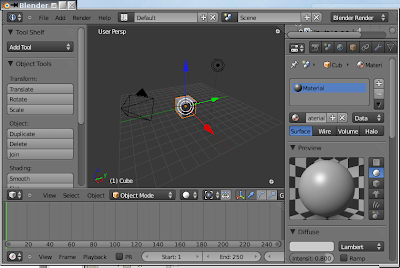This image links to the Tufts course site and they have a complete blender tutorial there, however Blender is changing, and how much, is the question. I haven't downloaded the latest revision and so I can't say from experience. I noticed several comments that there are major differences. It is a very complicate program and rearranging it seems to be a bad idea. Extending and maintaining backward compatibility is the best approach. I guess I will see now as it has piqued my interest to see how different the interface and usage is.


It is downloading and so I will report what I learn here. In a matter of minutes with the software, I can say it is usable and the layout is the big difference, which is an improvement. It looks more professional and the layout is flexible. It is a win and I will use it a bit to see what is new.
I will probably study some Tufts courses on bacteriology as I play with it and if there is something really important or critical, I will post the information. Actually I am reviewing UCLA genetic engineering. The link is HERE. It is sad that 26,000 people watched video one and from there it drops to 200 people out of 7 billion. It is a free understanding of how genetic engineering works and also the scientific method. I have already taken this course and I have also cloned many different organisms. It always helps to look at these things again and it brings to mind some things that didn't occur or sink in the first time. While 200 people learn this, 18,038,590 would watch "Hot for Words". I got a feeling that I am correct in assuming that 1 in 100 million people actually understand WTF is really going on. That means about 60 on the entire planet. An interesting joke I heard in a Stanford lecture is that students feel cheated if they have to stay the full hour of a class and enriched if they get less education when they are paying 10's of thousands of dollars for it.
I am following along with the DNA programming, like I do with C or Python programming and downloading the programs and assembling them, then, modifying them to be sure I know how to use them. So I downloaded the DNA sequence to put an eye on the leg of a fly and I decided I should make a squirrel with an eye on its tail to see if I know how this works. I did "DNA configure", then "DNA make" and then "sudo make install -DNA --squirrel". That is a joke. About 8 hours of any subject is about as much as I can take in a day without getting stressed. I finished the Java from Stanford yesterday and that clarified some issues of the methods used with Java specifically.
New discoveries in the nature of n-D information and I will post some pictures of what I discovered when the program runs a bit better. It does manifolds and derivatives and integrals across dimensions and the methods are somewhat tricky. If you do derivatives on two dimensions you can have several forms that develop, like hill, valley, saddle or just a simple slope. In higher dimensions it becomes more complex and the shapes have no name that correlate with experience. The relationships still exist and a 5 dimensional object can have a slope in some composite direction. The fact that there is no "car analogy" to apply is a bit daunting. It's like a car with fenders that bend into an infinite number of dimensions with an infinitely variable value. So the fender gets bent in this n-space and it takes some seriously complex body work to pound it back to shape. It's all in knowing where to strike with the hammer.



0 comments:
Post a Comment